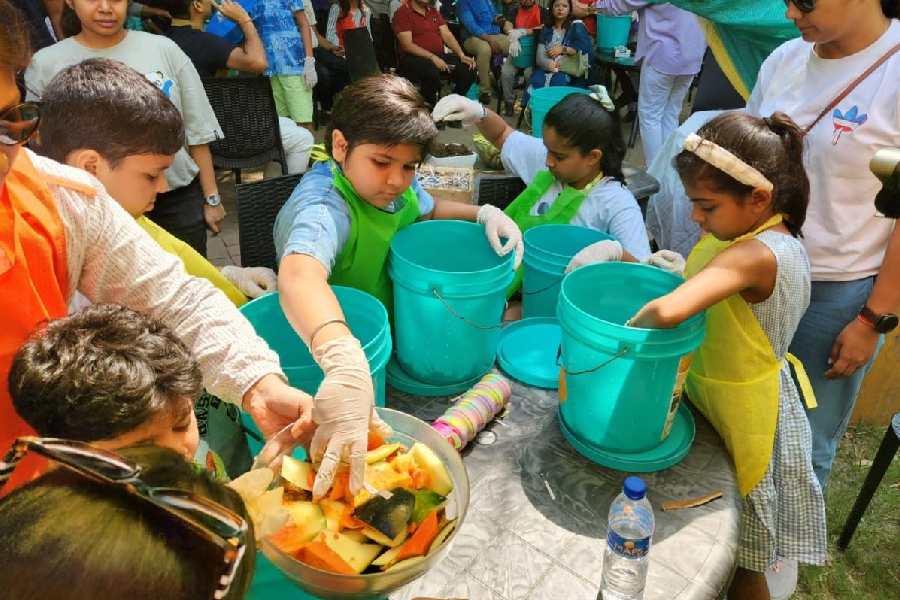An Earth Day celebration recently taught participants to make fertiliser out of items that otherwise go waste at home — by composting.
The event “Compost carnival: waste not, compost lots” was held at a Sector I hotel and hosted by the NGO Mamta Sumit Binani Foundation. In attendance were children and their parents who tried composting firsthand.
Why compost
India produces 1,60,000 metric tonnes of waste a day and 98 per cent of it is mismanaged, said Shital Bavishi, who was conducting the workshop. Shital is an environmental activist and founder of Beejum, a group that promotes sustainable practices.
“The per capita waste in India is 700g per day. This figure spiked since the pandemic, largely due to the increased use of online food and grocery delivery apps. The plastic containers used to pack this food significantly contribute to this rise,” explained the lady, who then turned to ask the children where their rubbish goes. The kids could only come up with answers like: “It is thrown in the dustbin” or “It goes out”.
“It is tragic how despite environment clubs in schools, kids don’t even know where trash goes once it is out of their homes,” Shital noted. “All our trash ends up in landfills, which have become enormous in volume and are threatening to bury cities. Methane, a greenhouse gas, gets released from landfills and adds significantly to global warming.”

Shital Bavishi explains composting to the audience Picture by Brinda Sarkar
But if we compost, we turn the kitchen waste portion of our garbage into fertiliser. It’s nutrition for plants and is that much less trash sent to landfills. “These days we need to make an effort to compost, but historically, our waste would decompose naturally, enriching the soil. The challenge today is the plastic in the waste that obstructs decomposition,” explained Shital, who has been living a zero-waste lifestyle for a decade.
How to compost
¨ Use a plastic bucket that has a lid. Despite attacking plastic, we often resort to it due to its practical benefits. What’s important is to steer clear of single-use plastics. You can reuse an old plastic bucket and punch ho¬ around it for ventilation
¨ The first layer in the bucket needs dry carbon so put shredded cardboard bits in it
¨ Next, dump all kitchen waste like vegetable and fruit peels. Cut or tear them in small bit. Don’t blend them in the mixer.
¨Pour in left-over buttermilk but no other dairy items. You can safely add hair, nail, and pet fur but not their excreta. When dumping banana peels, remember to pull out the sticker that’s sometimes stuck to it. You can add eggshells but no non-vegetarian food. Also, oil will not decompose easily so you can neither add oil nor any leftover food that has been cooked in oil.
¨ Next, add a layer or tea leaves, but sieve it first. Otherwise, the sugar will attract ants.
¨ The final layer needs dry leaves and shredded paper. It’s best not to use old newspapers as that will have chemicals in the form of ink. If possible, add cocopeat (a growing medium for plants made of coconut husk).
¨ Once you close the lid, keep the bucket in the shade.
¨ The compost will be ready in a month. To prepare it for use, spread it out in the sun for two to three days to dry. Sift and sieve it to ensure that any larger chunks are broken down into a uniform, grainy texture.
¨ Compost is most effective when mixed with cocopeat and the soil mixture you’re preparing for your plants. You may also dilute the compost in water and use it as a nutrient-rich solution for the plants.
Eager to try
The audience was quite excited by the demonstration. “I had heard of composting before but this is the first time I tried it out,” said Akiraa Mehra, a Class VI student.
“We lived earlier in New Town’s Greenwood Elements, where they were strict about waste segregation. The garbage man wouldn’t accept the trash if wet and dry waste were mixed,” said her mother Ami Mehra. “We have now shifted to Hazra Road, where we continue to separate our waste into different bags but the collector mixes them during pick-up. Still, the kids want to continue segregating and I encourage the habit.”
Bishnu Lohia, an elderly participant, said he had tried composting at home but that it was raising a stink. “I learnt today that adding curd to the mixture creates an odour and that we must punch holes in the basket for ventilation,” he said, eager to introduce these hacks at home.
“Our NGO works on issues like sustainability and women’s empowerment and this hands-on workshop on composting seemed like an effective way to celebrate the 54th anniversary of Earth Day,” said Mamta Binani from the foundation. A resident of Swarnamani, near Mani Square, she started this foundation earlier this year with her husband.











